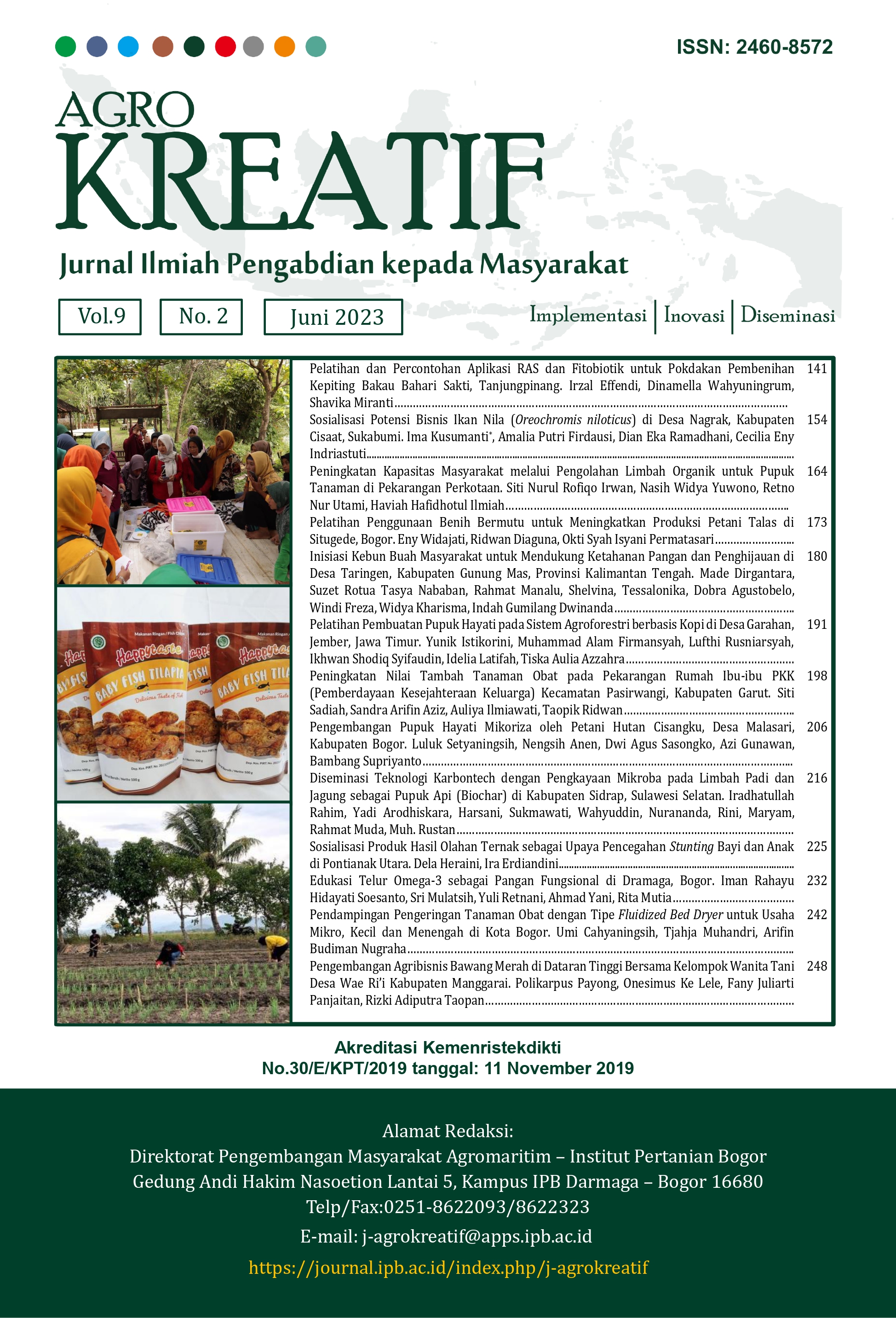Sosialisasi Produk Hasil Olahan Ternak sebagai Upaya Pencegahan Stunting Bayi dan Anak di Pontianak Utara
Abstract
This service is carried out to provide information about processed livestock products as an effort to prevent stunting in infants and children. The service was held on February 28, 2021 with female participants who were members of the Family Welfare Development (PKK) in the Siantan Hilir sub-district, North Pontianak. The method used in this service is socialization in the form of delivering information on processed livestock products as an effort to prevent stunting in infants and children. There are three stages carried out namely the stages of preparation, implementation, and evaluation. The outreach was carried out as targeted. All participants gained additional knowledge and understanding related to stunting and its prevention through consumption of processed livestock products which are not difficult to find. The low understanding before this socialization was carried out then the participants became more aware of the importance of preventing stunting starting from babies in the womb to post-delivery. There is an opportunity to change the behavior of participants in neglecting the food and snacks consumed by their children. Therefore, it is necessary to do the same thing at various levels of society as participants in a wider socialization.
Downloads
References
Aryastami NK. 2017. Kajian Kebijakan dan Penanggulangan Masalah Gizi Stunting di Indonesia. Buletin Penelitian Kesehatan. 45(4): 233–240. https://doi.org/10.22435/bpk.v45i4.7465.233-240
Cameron, L., Chase, C., Haque, S., Joseph, G., Pinto, R., & Wang, Q. (2021). Childhood stunting and cognitive effects of water and sanitation in Indonesia. Economics and Human Biology, 40(May 2019), 100944. https://doi.org/10.1016/j.ehb.2020.100944
Damayanti RA, Muniroh L, Farapti F. 2017. Perbedaan Tingkat Kecukupan Zat Gizi Dan Riwayat Pemberian Asi Eksklusif Pada Balita Stunting dan Non Stunting. Media Gizi Indonesia. 11(1): 61‒69. https://doi.org/10.20473/mgi.v11i1.61-69
Margawati A, Astuti AM. 2018. Pengetahuan ibu, pola makan dan status gizi pada anak stunting usia 1‒5 tahun di Kelurahan Bangetayu, Kecamatan Genuk, Semarang. Jurnal Gizi Indonesia (The Indonesian Journal of Nutrition). 6(2): 82–89. https://doi.org/10.14710/jgi.6.2.82-89
Nurfatimah N, Anakoda P, Ramadhan K, Entoh C, Sitorus SBM, Longgupa LW. 2021. Perilaku Pencegahan Stunting pada Ibu Hamil. Poltekita : Jurnal Ilmu Kesehatan. 15(2): 97–104. https://doi.org/10.33860/jik.v15i2.475
Rahmadhita K. 2020. Permasalahan Stunting dan Pencegahannya. Jurnal Ilmiah Kesehatan Sandi Husada. 11(1): 225–229. https://doi.org/10.35816/jiskh.v11i1.253
Ramadhani N, Herlina H, Pratiwi AC. 2019. Perbandingan Kadar Protein Telur pada Telur Ayam dengan Metode Spektrofotometri Vis. Kartika : Jurnal Ilmiah Farmasi. 6(2): 53‒56. https://doi.org/10.26874/kjif.v6i2.142
Rizal MF, van Doorslaer E. 2019. Explaining the fall of socioeconomic inequality in childhood stunting in Indonesia. SSM-Population Health. 9(December 2019): 100469. https://doi.org/10.1016/j.ssmph.2019.100469
Saputri RA, Tumangger J. 2019. Hulu-Hilir Penanggulangan Stunting di Indonesia. Journal of Political Issues. 1(1): 1–9. https://doi.org/10.33019/jpi.v1i1.2
Sofiana MSJ, Yuliono A, Warsidah, Safitri I. 2021. Sosialisasi Pemanfaatan Pangan Hasil Laut dan Diversifikasi Olahannya Sebagai Usaha Menanggulangi Stunting Pada Anak Balita di Kalimantan Barat. Journal of Community Engagement in Health. 4(1): 103–112. http://jceh.orghttps//doi.org/10.30994/jceh.v4i1.121
Trihono, Atmarita, Tjandrarini DH, Irawati A, Utami NH, Tejayanti T, Nurlinawati I. 2015. Pendek (Stunting) Di Indonesia, Masalah dan Solusinya. Jakarta (ID): Badan Penelitian dan Pengembangan Kesehatan Kementerian Kesehatan RI.
Wijaya H, Prayanto W, Yudani HD. 2014. Perancangan Video Edukasi Tentang Manfaat Dan Kandungan Gizi Susu Sapi Segar Untuk Anak-Anak. Jurnal DKV Adiwarna, Universitas Kristen Petra. 1(4): 1‒12.
Yoris L, Tiven, Pattisinay. 2016. Studi Tentang Pola Konsumsi Pangan Sumber Protein Hewani Asal Ternak Pada Mahasiswa Fakultas Pertanian Unpatti. Jurnal Makila. IX: 108–115.
This work is licensed under a Creative Commons Attribution-NonCommercial 4.0 International License.



















